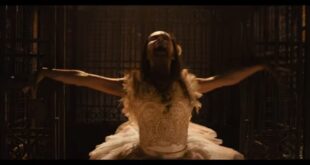The rape-revenge subgenre is the red-headed stepchild of horror, and maybe it should be. Historically, it is a fixation on sexual violence against women written and directed by men. It is hard not to view the products as exploitive when they are all male voices telling of a female experience. The state of the subgenre begs the question: how would a woman tell it differently?
Rape-revenge horror and I have always had a tenuous relationship. I foolishly watched The Last House on the Left remake while working as a contractor in Iraq, where rape was a very real possibility every day. After I watched the brutal and poignant Irreversible, I found myself actively wondering how a woman would capture the story of rape-revenge differently. Would it be more graphic and visceral to place the audience in the horror of the act? Would it be more subdued to avoid fetishizing the crime?

Revenge (one of PopHorror’s favorite films of 2018 – read the review here) is not the first rape-revenge horror movie written or directed by a woman. American Mary (one of my favorite horror movies ever) comes immediately to mind. However, Revenge is the latest in the subgenre that has been dancing on everyone’s tongues and had horror site writers twittering. When you search “rape-revenge horror” (as I did for this article), Revenge is in the top results.
So, how does writer/director Coralie Fargeat tell this rape story differently?
First, Fargeat gives us Jen (Matilda Anna Ingrid Lutz). Rather than being an innocent victim in the wrong place at the wrong time, Jen bounces around a desert vacation home as the half-naked mistress of her married boyfriend, Richard (Kevin Janssens). When she flirts with some unexpected guests, one interprets her friendliness and sexuality as an invitation. Fargeat forces the audience to confront the idea of “asking for it.” Her victim is real, flawed, a girl we have all known.

The rape scene itself is handled more gently than I think I expected from a woman, especially in a French horror movie. The French have potentially traumatized me the most through film. The assault is not subtle, but the attacker’s slut shaming of Jen is almost more uncomfortable than the attack itself. Fargeat portrays enough of the rape to get the point across, to make the audience squirm just enough. Yet, the assault is not the focus of the film. It is not a gratuitous, elongated, unnecessary fixation on the act itself.
Typical to rape-revenge, after her assault, Jen is discarded and left for dead. In this particular case, she is not dispatched by her attacker but rather by Richard for inconveniencing him, threatening to expose their affair and disrupt his marriage. Then, again formulaically, Jen survives and comes back to exact her vengeance.
One Body, Two Women
By my own personal viewing, I would say the Jen from Act One does not survive. Rather, I think she dies and comes back as something more, someone stronger and suddenly capable of physical combat and sharp shooting.

Near-dead or undead, Jen sheds her sex kitten mistress persona. Yet, Fargeat does not change the way the camera follows her. When Jen is sexy and clean, there are shots roaming her tight body. When Jen is bloodied and dirty, there are still shots roaming her tight body. She’s still sexy after surviving; she’s still attractive without the validation of the other male characters.
And perhaps the most important equalizer in the entire rendering is the male nudity. Rape-revenge almost always includes the female victim being violently stripped (to varying degrees) and assaulted. Yet, in the final confrontation, Revenge gives us a male antagonist, Richard, completely nude and fighting for his life. As Jen physically wounds the naked man who threw her off a cliff to die, she succeeds in fully turning the tables on him. Even in her underwear, she is more clothed than he is. This simple wardrobe choice (or lack thereof) is significant.

Revenge does tell the rape-revenge story differently. Through the female lens, Fargeat gives a real, flawed heroine who confronts the idea of the victim “asking for it” and victim blaming. She allows Jen to retain her sexual attractiveness both before the assault and while she’s claiming her revenge. And she equalizes victim and murderer in bloodied nudity.
Hopefully, Revenge is one instance of many more upcoming female voices in the horror conversation. You can see the film now on Amazon Prime.
 PopHorror Let's Get Scared
PopHorror Let's Get Scared




